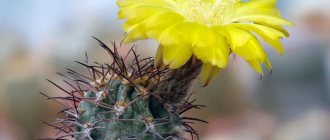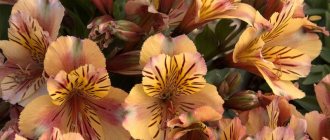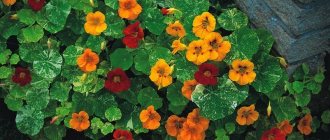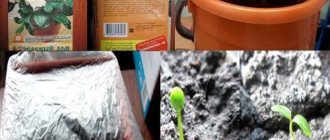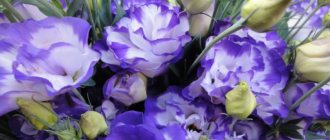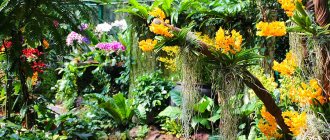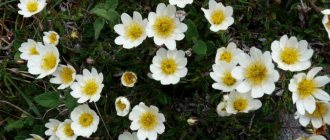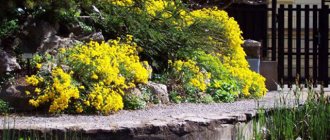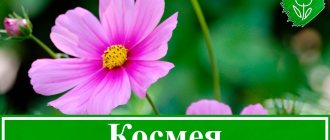What you need to know about Brugmansia
Brugmansia is a heat-loving flower that can be grown both in containers and in open ground. The plant is represented by small trees and shrubs. Some varieties can reach 5 meters in height.
The flower does not like drafts or lack of light. Needs replanting, fertilizing and timely pruning. The first pruning is carried out in the second year of the plant’s life - dry branches are removed and new ones are shortened.
Brugmansia is sown from January to March, and it blooms from July to December.
Subtleties of care
When cultivating Brugmansia, you need to know that it loves light and warmth. In winter, if it is not possible to provide such conditions, you can leave it in a cool room until spring (the plant will be at rest). “Archangel's trumpets”, which grow in tubs, develop better at a temperature of +23–25°; in summer, the room needs to be ventilated or the plant should be taken out into the fresh air. For an indoor green pet, the south side with good lighting is more suitable.
Watering
During the warm period, the plant needs abundant and regular watering; after flowering, it needs to be reduced somewhat. Brugmansia responds well to spraying, but you must not allow water to get on the buds. During the dormant period - in winter - it is recommended to water the flower rarely and with a small amount of water, but do not allow the soil to dry out. If the plant blooms and develops in winter, then the moisture should be normal. It is better to take water for irrigation that is settled and not cold.
Top dressing
You should start feeding Brugmansia in the spring; for this you can take a solution of mullein in a ratio of 1:10 or fertilizer with nitrogen. During the summer, the plant is fertilized with complex mineral and organic fertilizers once every 1–2 weeks. During flowering, you need to add compounds with potassium and phosphorus. During the cold period, if the flower is not in a state of rest, it is enough to feed it once a month, otherwise fertilizers are not used.
Trimming
Brugmansia is characterized by fairly rapid growth, so it needs to be trimmed, in addition, in this way you can form the crown and give it the desired shape. Experienced gardeners recommend pruning in early spring. First, old and dry branches are removed, the rest are shortened by a third. The plant can be pruned for the first time two years after the first flowering.
Preparing for winter
For wintering, it is recommended to move Brugmansia to a cool room from +13 degrees and below (up to +5), then the plant will be in a dormant period and its growth stops until spring. The flower is not fed and watered rarely, but it is recommended to spray and ventilate regularly. As for lighting, the plant should be provided with additional lighting (optimally daylight hours should last about 12 hours). Plants that grow in open soil are dug up for the winter and divided into several parts (optional). Each of them is placed in an individual container and stored in the basement.
It may happen that the top of the plant froze during the winter (the temperature was too low), then in the spring it needs to be cut off and rooted in water, and then planted in the usual way. If you want Brugmansia to continue to bloom in winter, it should provide certain conditions:
- warm room;
- good lighting.
It must be remembered that in this case the plant is quickly depleted and may die in a few years. Therefore, in order to enjoy the beauty of the “archangel’s trumpets” longer, it is better to properly prepare the plant for the period of winter dormancy. As you can see, caring for Brugmansia is not difficult, but you can get a spectacular flower that will decorate any home or garden.
Seed preparation
The germination rate of Brugmansia seeds is 70-80%, so it is important to prepare them for sowing to increase the chances of getting more beautiful plants.
Preparation takes place in 3 stages:
- Disinfection - keep the seeds for half an hour in a solution of Fitosporin (can be replaced with potassium permanganate).
- Soaking - to speed up germination, seed material is dipped in Epin solution.
- Breaking the shell - using any sharp object, cut the seed shell to make it easier for the sprout to release.
Caring for Brugmansia after flowering: preparing for wintering (photo)
Brugmansia overwinters indoors. For a long winter, the plant must be prepared in advance.
• The flower is transplanted into spacious containers with a volume of at least 15 liters with good drainage.
• When the night temperature drops to 5-7 degrees, the pot with the plant is brought indoors. This could be a covered porch or a room.
• In heated rooms the plant continues to bloom for quite a long time, but it is better to give it a dormant period until spring. The temperature in the room where Brugmansia is kept should be +10 degrees.
During the dormant period, reduce watering to a minimum. At this time, the plant sheds its leaves, which will appear with the arrival of spring. You can keep the flower in such conditions in the basement or cold veranda.
You can save a tub until spring in a heated room
It is important to remember that such a plant will need additional lighting. Not every gardener can do this, because such a large flower takes up too much space
Soil preparation
It is not necessary to prepare the soil for sowing seeds with your own hands. In the case of Brugmansia, a ready-made commercial substrate for indoor flowers is quite suitable for you. The plant loves loose soil, so add perlite or sand. You can also improve its quality with humus.
The finished mixture is disinfected with Fitosporin solution.
The soil requirements of mature plants are slightly different. The mixture for them (for the purpose of transplanting into a larger pot) is prepared from peat, sand and clay. In open ground, Brugmansia prefers loam.
Ode to beauty
Its 30-centimeter bell flowers are amazing! It’s not for nothing that they are also called “angel trumpets” - if angels in heaven really announce their good deeds by playing trumpets, then these musical instruments should look exactly like this.
The Brugmansia bush grows large, up to 3-4 m, so you need to take care of its location in advance. Such an exquisite beauty should have enough light, warmth, protection from drafts and possible mechanical damage to its fragile, beautiful inflorescences.
And of course it would be a crime to shove a tub of Brugmansia into the far corner of the room! stunning flowers bloom , it willy-nilly outshine all other objects in the room, becoming the main decoration and an unsurpassed element of decor.
And nature has worked with special diligence on the colors of Brugmansias: from the most delicate shades of peach, cream, pink to radical acid colors, as well as two-, three- and even four-color colors, simple and terry.
And what an exquisitely delicate and at the same time strong aroma ! It fills the air around itself with the finest waves of aphrodesiac, lifts the mood, evokes desires... How to grow such a wonderful plant?
Sowing Brugmansia seeds
Sowing consists of five simple steps:
- The substrate is lightly watered so that it is moist, but at the same time loose.
- The seeds are carefully distributed over the surface at a distance of 3 cm from each other and pressed down slightly. Next they need to be sprinkled with a small ball of soil (0.5 cm).
- The container with the seeds is sent to a bright and warm (22-25°C) place. Seedlings need ten hours of daylight, so take care of lamps or other sources of additional lighting.
- The container is opened slightly several times a day. Condensation can be observed on the lid at this time. It must be removed with a clean napkin.
- From time to time the soil needs to be watered.
Brugmansia loves moisture, so spray the hatched seedlings with water using a spray bottle. They will appear at different times. You will see the first ones in two weeks, the rest will take several months.
Popular species and varieties in gardening
Brugmansia aurea is a tree that in nature can reach 6 meters, but in pots its growth is limited to 2 meters. Flowers in golden or cream shades.
Brugmansia candida - grows up to 4.5 m in height. It is an interspecific hybrid with white, slightly pink or cream flowers, intensely fragrant in the evenings. Varieties: “White Angel”, terry form “Adretta”, mini bush “Wooly White”.
Fragrant Brugmansia (Brugmansia suaveolens) . One of the most popular species, which attracts with its variety of varietal forms, hybrids and the heady aroma of yellow, pink, cream and white flowers. The most spectacular variety “Tricolor” with a unique combination of flowers of different colors. "Ambizu" is a dwarf form of bush with yellow flowers, pink Brugmansia "Aromagia rosea".
variety "Tricolor"
You can find many terry hybrids on sale, for example, “Angels Innovation”, “Angels Suprise”, “Angels Sunexplosion”, “Rosa Zauber”, “Miss October”, “Bolero”, “ANGELS ENJOY”, “Edna”. The unique hybrid form of Brugmansia cubensis is striking in its unusual shape of the flower corolla.
There are also decorative foliage varieties of the Variegata group: “Maya”, “Snowbank”, “Sublime”, “Sunset”, “Apricot Queen”.
Brugmansia. Description of the plant
Brugmansia (planting and care at home are presented in the article for informational purposes) is mainly cultivated in areas with a mild climate, for example, in the Caucasus, southern Europe and Crimea. In harsh climatic conditions, the flower may freeze.
The plant can grow in a personal plot, in a tub on the balcony and in a pot at home.
The height of the bush reaches approximately 2 m. In spring and summer, shoots grow quickly, but grow woody slowly. To create a beautiful flower, you need to regularly remove excess side branches. The leaves are characterized by an oval shape and smooth ends. The surface is covered with light fluff. The roots grow very quickly, forming a dense lump on the surface of the earth.
The flowers are tubular in shape and have a fragrant scent. Petals can be pink, white or yellow. In some varieties of Brugmansia, the color can change smoothly along the entire length.
The flowering stage occurs quite late, when the above-ground part of the plant is fully formed. Flowering has a wave-like character, so the bush can bloom in several stages. For garden crops, the period of bud formation begins at the end of summer, when it becomes quite cool in the evening. The plant can easily withstand temperatures reaching +5 °C.
Diving seedlings
When young seedlings have 4-5 leaves, you can start diving. To do this, you need to prepare separate containers with a volume of 0.5 l to 0.7 l. A good layer of drainage should be laid on their bottom. The substrate must be well moistened.
If the seedlings initially grew in one box or container, then their root system should be carefully separated, being careful not to damage it. Then plant each sprout in a separate container.
Those that grew in separate cups for seedlings or in a cassette with cells simply need to be transferred to another container.
In both cases, it is necessary to deepen the seedlings to the cotyledon leaves (these are the first two leaves that emerge to the surface).
When the root system fills the new container, you should select a pot that is 5 cm larger in diameter and height than the previous one and carry out another picking.
The number of transshipments during the first year of life can be 3-4 . During this time, the seedling can grow up to 60 cm in height, although 25-30 cm is also within normal limits.
How to grow a plant: step-by-step instructions
Brugmansia (planting and care at home will tell you how to grow the plant correctly) has been cultivated from seeds for a very long time and does not guarantee the preservation of the properties of the variety.
To reproduce, you must complete the following steps:
- The plant should be planted in early winter or spring.
- It is recommended to keep the seeds in Kornevin.
- You need to take the container with a light soil layer, distributing the workpieces to a depth of 1 mm, and then moistening it.
- Then the container must be covered with a transparent lid, ensuring a temperature of +25 ° C and good lighting.
- 14 days after the formation of seedlings, the film will need to be removed. Crops must be regularly sprayed with warm liquid at least 2 times a day.
- After the 5th leaf appears, the seedlings should be transplanted.
What does Brugmansia look like?
In nature, plants take the form of low trees or spreading shrubs with semi-lignified pagons, growing up to 3-11 m.
The leaves are large, from 10 to 30 cm in length and 4-18 cm in diameter, placed alternately along the stem. Their edge is solid or roughly serrated, and the entire leaf blade is covered with small fibers.
Luxurious tubular flowers of impressive size - from 14-50 cm in length and 10-35 cm in the circumference of the open corolla.
Their colors vary in a different palette: snow-white, cream, lemon yellow, apricot, soft pink, raspberry, light green and terracotta red.
The pleasant scent from single or clustered flowers of two or more spreads in the evening.
Methods of growing and propagating plants
The plant can be propagated by layering, vegetatively and by apical cuttings 20 cm long, which are rooted in early spring. Stem cuttings are suitable for propagation, but the bushes will bloom a little later than the flowers that were obtained from apical cuttings.
Brugmansia, which was grown from seeds, may not have maternal qualities. It will begin to bloom only 3–5 years after planting. Seeds are mainly obtained through artificial pollination. When the fruits are ripe and formed, they are cut and the seeds are removed.
Transplantation without the risk of injury. Step-by-step instruction
Brugmansia (planting and care at home will help flower breeders to properly transplant the plant without the risk of injury) tolerates the transplantation procedure normally if all actions are careful and correct.
Step-by-step instructions on how to replant a plant:
- The base of the container needs to be covered with a small amount of pebbles, charcoal and expanded clay. Next you will need to add a small amount of substrate.
- The plant along with the earthen ball must be transferred to a container. If voids appear, they will need to be filled with nutritious soil mixture.
- Finally, the soil must be compacted and moistened.
During the replanting process, it is permissible to slightly shorten the roots of the flower, cutting off rotting or dying parts.
Features of reproduction
There are two methods of propagating Brugmensia - generative (seeds) and vegetative (cuttings and air layering). Each species is used to one degree or another by summer residents.
Seed method
Propagation of Brugmansia by seeds is quite rare, and besides, planting a plant and caring for it is more difficult than using other methods of propagation
It is important to remember that no seed seller can ensure the exact germination of the material (the seed may germinate ten days after planting, or may not emerge from the ground at all)
The crop obtained using this method will begin to bloom only next year. Another disadvantage is that the varietal characteristics of hybrid varieties disappear during seed propagation.
Features of sowing:
first, it is important to prepare the seed material (for this, the seeds are placed in a growth stimulator for one day or their shell is scratched with the tip of a small knife); then the seeds are laid out in the soil to a depth of ten millimeters, the soil is moistened and covered with a film on top (at the planting site the temperature is maintained at 20 to 25 degrees Celsius); After the first shoots appear, the film must be removed, spraying the sprout with water continues until the fifth leaf develops on it, after which the crop is transplanted into a separate container.
It is important to remember that Brugmansia is a poisonous crop. All parts of the flower contain atropine, scopolamine and other toxic elements (intoxication can lead to diarrhea, loss of consciousness, and severe hallucinations)
This flower poses a particular danger to children who may accidentally taste the leaves or flowers of the plant. When cutting the crop, it is important to wear gloves so that its juice does not accidentally get on the skin of your hands.
Propagation procedure by cuttings
Considering all the disadvantages of propagation through seeds, many gardeners are wondering how to propagate a plant from cuttings. Cuttings are a fairly popular method of crop propagation, as it leads to a quick and effective effect. Cuttings are allowed to be carried out every year, but the best time is considered to be spring (after the end of the sap flow process) and autumn (before the onset of sub-zero temperatures).
Before growing a plant from a cutting, it is important to first select and prepare material for planting. For this, it is best to use apical shoots of a lignified type with a bud (up to 25 centimeters)
Experts also allow the use of side buds for this procedure, but in this case the flowering of the crop will begin a year and a half later.
After cutting the cuttings, it is important to free them from excess foliage. After this, the cuttings are placed in a container with soft warm water (usually activated carbon is added)
For best seed germination, it is important to keep the planting container warm.
Air layering
Flower growers can propagate Brugmansia not only using seeds and cuttings, but also by air layering. To do this, a transverse cut is made on lignified annual shoots (¼ of the part)
It is important to treat the incision with a root formation stimulator (Kornevin is most often used for this), wrap it with sphagnum, moisten it with water and place it in a separate film
It is important to water sphagnum moss from time to time. After seven weeks, you need to check the sprout for the presence of roots.
If they are present, then the shoot can be cut off, excess leaves removed and rooted in a container with a light and fertile soil mixture.
Brugmansia pests and diseases
Among the pests, the spider mite is the most common pest. As a rule, Brugmansias that grow in closed, poorly ventilated rooms with dry, warm air suffer from it. As a preventative measure, Brugmansias are regularly sprayed. Spraying should be abundant and uniform, as it usually settles on the inside of the leaf and in the internodes. On the street, despite its toxicity, Brugmansia can suffer from caterpillars and slugs that eat leaves and flowers. The juicy greens of Brugmansia are very tasty for aphids and other sucking insects. Damaged leaves turn yellow and fall off. The plant should be carefully inspected. The presence of damage on the leaves or shriveled buds may indicate a pest attack. Then you should treat the plant two or three times a week with an appropriate preparation (Bio Insect, Plant Spray).
Low-growing tomatoes that do not require pinching for greenhouses
Treatment of fruit trees and shrubs with urea in spring
Treatment of trees and shrubs in spring
Like other members of the nightshade family, Brugmansias are quite poisonous. They say that there is even a ban on planting floripondio, as Brugmansia is called in Argentina, in crowded public places due to toxic and psychotropic substances contained in large quantities in all parts of the plant and especially in its seeds. The high hallucinogenic properties of Brugmansia have long been used by South American Indians in spiritualistic rituals and for medicinal purposes. Currently, in the northern, warmer provinces of Argentina, Brugmansia is cultivated on an industrial scale, growing plants for the needs of the biochemical and pharmacological industries in order to obtain valuable alkaloids scopolamine and atropine. For people with sensitive skin, Brugmansia juice can cause irritation, so it is better to wear gloves when pruning large numbers of shoots.
Plant propagation instructions
The plant must be propagated by cuttings in spring or autumn.
To do this, follow these steps:
- Young woody stems with a growing point, which have 3 buds, should be trimmed and foliage removed.
- You will need to pour liquid with soluble carbon into an opaque container and send the planting material into it.
- A temperature of +20 °C and sufficient lighting should be created.
- When the first roots appear after 14 days, you will need to transplant the workpieces into separate containers.
- The soil should be loose and breathable based on perlite, peat and sand in a ratio of 1:2:1.
A flower propagated by layering does not grow tall, but is capable of blooming quite luxuriantly.
To do this, at the end of spring or beginning of summer, you should do the following:
- On last year's upper shoots, it is necessary to make Y-shaped cuts of 1/4 thickness, generously irrigating with a growth stimulator.
- Next, you will need to place moss on the cuts, wrapping the shoots with film and tying them with thread.
- The moss must be moistened with a syringe for 30 days.
- Roots will begin to form at approximately 40–50 days. During this period, the foliage and buds must be removed from the branch, the moss must be removed, and the shoot must be cut off and placed in nutritious soil.
- To speed up the rooting process, the plant must be sprayed daily and protected from direct sunlight.
